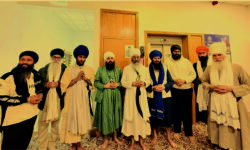-Mooney Singh
When Guru Nanak, the founder of the Sikh religion, came to bless the world, he chose to do so through the Holy Word set to music. Wherever he traveled, his divine poems were communicated in a relaxed and deeply enriching manner, conveying whatever the Formless One wished to express to humankind through His prophet.
Audiences were charmed, entranced, and inspired by this unique poet-singer from Punjab. He journeyed south, east, north, and west throughout the Indian subcontinent and beyond, singing in Sant Bhasha, the lingua franca of his time, and using the terminology of the regions and countries he visited. He established centers that served the poor and needy through langar (free communal kitchen), provided free accommodation for travelers, and offered places of worship where shabad kirtan conveyed the Guru’s message and blessings daily. Shabad kirtan transcended all barriers of caste and religious practices, thus becoming central to Sikh religious worship. The Guru’s unique method of presenting the philosophy of the Word continues to touch the hearts of millions.
Guru Nanak was a prophet and a world teacher, not merely an instructor of others’ ideas. He was an enlightener with divine inspiration, whose words and actions transformed the times and cultures. He acted fearlessly, confronting despotic rulers when necessary, and always emerging victorious. He was learned in all the scriptures and many languages, yet he broke with tradition and sang and wrote in the common tongue of the day, as his message was intended for all, particularly the neglected classes lacking social means and education.
Guru Nanak possessed such compassion for the people that he relinquished his high-caste privileges and identified with the lower sections of society. His wisdom was a wellspring from which anyone could drink. He chose poetry and music as his medium of communication. He and Bhai Mardana, his rabab musician, traveled on foot throughout the world, traversing dangerous forests, perilous mountains, and hot deserts to bring the Divine Word to the hearts of the people.
Nanak’s style of preaching is unique among world prophets. He would simply sit under the cool shade of a tree with his companion and begin to sing to the accompaniment of Mardana’s five-string rabab. His melodious voice attracted people like bees to honey. People came and, in these simple gatherings, were absorbed in an experience of peace and quiet ecstasy. They understood the words of the musical poems because, wherever Nanak went, he used words and concepts familiar to his listeners. When speaking to yogis, he might use Ramkali Raga, appreciated for its mood of detachment. When speaking to Muslims, he used the Names of God they uttered in their namaz. He traveled in Muslim countries and wrote and sang in colloquial Persian. He also adapted local folk tunes and created ragas like Tukhari. Like any true prophet, Guru Nanak descended to the level of his audience and then lifted them to the highest heights through the power of the Divine Word and music.
The twentieth century witnessed unprecedented developments in communication and technology, as well as in literary translation. Literary and religious texts have been translated into every language on the globe. While no one believes the original can be replaced, wise translators recognize the difficulties inherent in faithfully and stylistically transferring ideas from the source language to the target language. Nonetheless, without translation, one culture cannot understand the ideas and motivating spiritual passions of another. This understanding is crucial in the age of the global village if the world is to avoid planetary conflagration and establish a new order of humankind founded on mutual respect and a vision of the One Reality behind all shapes and forms.
Sikhi, by its very concept, is a dialogue. Its cornerstone is the clear-sighted acknowledgment of the One Reality behind diversity and the acceptance of all sincere paths to God. It, therefore, occupies a unique place among the family of religions. It can illuminate an age of religious intolerance through its commitment to selfless service. Indeed, Guru Nanak showed the way towards universal love through his practical life, helping the needy at all times and nourishing them through the power of the Word combined with music.
This is a great blessing for Sikhs and non-Sikhs alike, for music is indeed an interfaith language that can create harmony where there is discord, health where there is disease, and enlightenment where there is ignorance. Music is the white horse upon which the Shabad-Guru rides most regally.
The Guru first attracted his sangat through kirtan. Music in various ragas, appropriate to the time of day, season, or occasion, intensifies the intellectual content of the written shabad. Music creates an emotional depth within the listener for contemplation. If reciting the text is sometimes a duty, then listening to the shabad in kirtan form is a joy that naturally strengthens the powers of concentration, preparing it for the experience of simran. Listening to the outer kirtan leads to the inner kirtan.
Why shouldn’t we share the universal message of Gurbani in musical translation, so that non-Punjabis can understand and appreciate it? The power of kirtan is so great that singing the original shabad alongside its translation (according to the language of the country where it is being performed) would have a profound impact.
These days, Westerners have turned their attention to Eastern forms of spirituality. Sikhi, as yet, is little known, except to a few thousand North American Sikh converts. But there are millions of others who are awakening spiritually but have no clear path to God. Guru Nanak gave us the gift of kirtan. It is the yoga of Sikhi, preparing us for the Guru-given gift of simran. Music is the great bridge that can bring the Gurus’ blessings into the lives of all races and into world culture.
Such kirtan, delivering the shabad and its translation in the same raga, could truly bring the Guru’s message to the larger world, while still preserving the radiant conscious energy. In Western countries, a new category of music, called World Music, has emerged. It takes music from its ethnic setting and mixes it with contemporary instruments and ideas. Exponents like Australia’s Dya Singh group have brought Gurbani before thousands of Westerners who are now at least aware of the Sikh religion.
World Music has become very popular among those looking back to traditional forms of music for spiritual sustenance. Secular music has its place, but Gurbani is devotional by concept and not mere entertainment. Its purity must be maintained and not diluted in any interfaith setting. Guru Nanak gave his blessings to the world through the simplest and most direct medium: words set to music. His intention was to reach the masses, not just the select few.
Would it serve the Guru’s purpose if Gurbani remained untranslated and unsung, given that shabad kirtan can only be fully enjoyed by those who understand it? Translation is also crucial for propagating the Guru’s Word to the next generation. These days, young Punjabi Sikhs are losing touch with Gurmukhi, the linguistic wellspring of their heritage, particularly in foreign countries where Sikhs have settled. Most do not understand what the ragis are singing. People tend to go to the gurdwara out of habit and custom, but young people, with their heart for rebellion and increased educational opportunities, are honest enough to reject hypocrisy when they don’t feel spiritual light shining on them.
Thus, due to a lack of inspiration, dearth of positive spiritual role models, and absence of Gurbani knowledge, they are drifting and drowning in the electronic sea of the urban world’s cultural glare, which is committed only to satisfying materialistic desires. Consequently, Gurbani is often perceived as archaic and old-fashioned. This is perhaps the fate of language generally.
Fortunately, the institution of Shabad Kirtan, with its timeless appeal through music, remains the medium of instruction and communication of Sikhi. All religious services center around the singing (kirtan) of Gurbani. It keeps interest fresh in approaching the Guru’s psalms on the page. If the shabad is inscribed in the heart of the listener, its innate power will one day lead him or her toward the deep well of wisdom beneath the text, for Gurbani can never die. It is the storehouse of amrit, supposedly found only in heaven. In mythology, both gods and demons fought over it to gain immortality, but in reality, it was Guru Nanak and his successors who brought it to earth and made it available to all people through Sri Guru Granth Sahib.
Perhaps we must now consciously sing the shabad in a relevant way for those who do not understand it. They will surely be re-inspired to learn Gurmukhi and study Gurbani in the original.
Guru Nanak brought down the message from the Divine. Mardana’s rabab was the musical midwife that gave birth to a tradition of spiritual practice through music. The Guru’s message is timeless and for all people, regardless of race, language, creed, caste, or culture. Kirtan is the Guru’s gift to the world.
Bol Mardania Sat Kartar!
Sing, O Mardana, the Creator is True!








